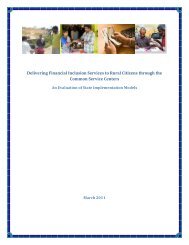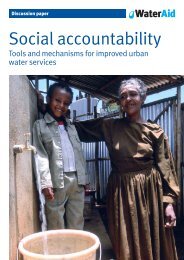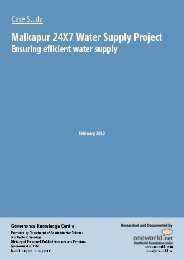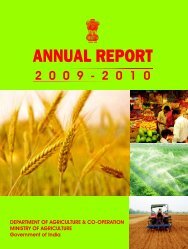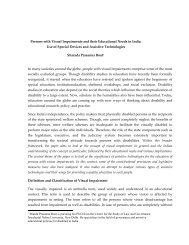underl<strong>in</strong>e the safety and protection measures needed for thisprocess of reclamation and the <strong>in</strong>clusion of voices, desires,and needs of all those who are full and active stakeholdersand constituents <strong>in</strong> every <strong>gov</strong>ernance and <strong>in</strong>vestmentprocess.Certa<strong>in</strong> groups and communities face social andeconomic “exclusion” and political marg<strong>in</strong>alisation due totheir caste, class, gender, age, religious affiliation, region,sexuality, disability, marital status, education, or liv<strong>in</strong>gwith HIV and/or other stigmatised health conditions.Consequently, our primary attempt has been to focus ondevelop<strong>in</strong>g plans, policies, and schemes to address this gap.All our thematic papers and <strong>in</strong>puts adopt approaches thatspecifically take <strong>in</strong>to account the needs and desires of thesesocially, culturally, and economically marg<strong>in</strong>alised groupsand communities and attempt to work towards mitigat<strong>in</strong>gthe effects of this marg<strong>in</strong>alisation/exclusion to ensure socialand distributive justice. In our view, these groups have sofar been regarded as “not quite citizens” and certa<strong>in</strong>ly notfull citizens.A case <strong>in</strong> po<strong>in</strong>t is the faulty categorisation of keyunder-served groups. For example, take the categories of‘women’ and ‘children’. The practice of clubb<strong>in</strong>g womenalong with children <strong>in</strong> a separate chapter of the current11th Plan document has served neither the woman nor thechild. Not only does this reduce women and children toexclusive reproductive and dependent roles, but also takesaway from their productive and social potential. This cannotqualify as any k<strong>in</strong>d of human resource development for thepublic good. Similar examples can be given for all the otherexcluded and marg<strong>in</strong>alised groups with whom we have beenengaged.Therefore, we have adopted a perspective of plann<strong>in</strong>gthat uses the concerns of the most marg<strong>in</strong>alised as anoverarch<strong>in</strong>g, cross-cutt<strong>in</strong>g concern, with the primaryobjective of promot<strong>in</strong>g growth with justice and <strong>in</strong>clusion ofall citizens <strong>in</strong> development. We stand by this.Illustrative examples of how rights to essentialentitlements actually play out demonstrate what we mean.Everyone has a right to all the essential entitlements for theirsurvival, development, dignity, and happ<strong>in</strong>ess and should beprovided these. Among these are protection of life; food andnutrition security; safe, clean and regular supply of dr<strong>in</strong>k<strong>in</strong>gwater; affordable and clean sanitation facilities; securehous<strong>in</strong>g; equal and affordable quality education; susta<strong>in</strong>ableand safe livelihood options; quality public health services;access to natural resources; social security provisions; cheaptransportation; <strong>in</strong>frastructure; safety and protection, allof which are easily accessible from where they live. TheGovernment, <strong>in</strong> our view, has a duty to provide these to all.Is there sufficient and conscious State <strong>in</strong>vestment <strong>in</strong>ensur<strong>in</strong>g this? Only this can end the cont<strong>in</strong>ued cycle ofvicious poverty and exclusion and move India towardseconomic prosperity for all. Our proposals for the Planapproach are therefore deeply rooted <strong>in</strong> this belief and allsuggestions to strengthen exist<strong>in</strong>g schemes and plans as wellas suggestions for new measures have been formulated fromthis perspective.We further believe that all groups and citizens of ourcountry have equal rights as citizens, stakeholders and ownersof all the resources available to them and their communities.All processes that affect these resources affect them and theirlivelihoods. We believe it is necessary to empower all citizens,especially the socially and economically excluded, with theright to monitor all schemes and programmes as owners andparticipants of all development and <strong>gov</strong>ernance processes <strong>in</strong>their areas of residence. This further ensures decentralisationof all plann<strong>in</strong>g, implementation, and monitor<strong>in</strong>g processes.Such an approach would ensure that all plans and schemeswill be owned and developed by the people and will bemean<strong>in</strong>gful and structured to address the gaps <strong>in</strong> their needsand desires.Concern for India’s environment and commitment tounderstand<strong>in</strong>g and address<strong>in</strong>g such a concern must be apillar of this and future Plans. Our <strong>in</strong>puts emphasise that thecrucial need to move to more aware and <strong>in</strong>formed plann<strong>in</strong>gand action to ensure climate justice and the susta<strong>in</strong>ability ofthe environment cannot be postponed to a future Plan. A coreconcern is the issue of the ownership, control, management,and utilisation of all natural resources and national assetsthat are <strong>in</strong> the <strong>in</strong>terest of the people. We believe that social,economic, and environmental marg<strong>in</strong>alisation are at the rootof a great deal of eng<strong>in</strong>eered violence and conflict, much ofit promoted by state agencies, that may be easily addressedby mak<strong>in</strong>g planned efforts to ensure justice.We <strong>in</strong>vite a re-exam<strong>in</strong>ation of the assumption that it ispopulation pressure alone that imperils the environmentalbalance of resources, renewability, and the common people’suse or expectation of land, water, and forests. It is necessaryto recognise the impacts of market-<strong>in</strong>fluenced decisions onuse and exploitation of natural resources. These not onlyupset and dim<strong>in</strong>ish positive conservation traditions but alsomove benefits out of the people’s hands.8
Overall, the case for market-led growth should notgo unquestioned. Our process has sought to analyse whatmakes a “people’s Plan” authentic. If the core developmentobjective is to better the lot and brighten the prospects ofthe common citizen, it must be argued that the nationalresolve should be for markets to serve and secure the hopesand happ<strong>in</strong>ess of the people rather than for the people –and the use of their energies and talents – to be geared tobenefit the market. The seedbeds of a prosperous republic,which deserve recognition rather than replacement <strong>in</strong>India’s quest for genu<strong>in</strong>e growth, are the little economies ofneighbourhoods and communities that draw upon local skillsand resources and cater to local requirements. This does notat all imply shutt<strong>in</strong>g the door on access to new technologiesand products. We believe that advocat<strong>in</strong>g privatisationof resources will lead to the further marg<strong>in</strong>alisation anddisempowerment of large sections of society.With the utilisation of this livelihood approach, wetherefore reiterate that people own and have a right tothe commons and common resources – and to chart theirown course towards a dest<strong>in</strong>ation of holistic developmenttrue to the country’s ideals. By this, we mean for examplethat plann<strong>in</strong>g should be livelihood-based, people-centric,pro-poor, and owned by the people themselves, as this <strong>in</strong>turn warrants that any developmental scheme and plan isenvironmentally susta<strong>in</strong>able.It is regularly argued – and expla<strong>in</strong>ed – that a Five-YearPlan is an economic plan, about <strong>in</strong>tentions to spend. If theseare its conf<strong>in</strong>es, India’s planners must reveal the ideologyand the development manifesto to which it relates. It is <strong>in</strong>this endeavour that the voluntary sector and civil societyhave the responsibility to seek, and f<strong>in</strong>d, and understandwhat the people really aspire for – and to strive to make ita reality.These are for us the key pr<strong>in</strong>ciples for our <strong>in</strong>puts.We believe that respect for them will facilitate and builda prosperous India while simultaneously secur<strong>in</strong>g redistributive,economic and social justice. This will furtherresult <strong>in</strong> “growth” for all rather than for a select few. In orderto ensure this, the forthcom<strong>in</strong>g Approach Paper to the 12 thFive-Year Plan needs to address the follow<strong>in</strong>g key concernsand recommendations:1. GDP growth alone as a goal of plann<strong>in</strong>g is rejectedby all the civil society groups. We suggest <strong>in</strong>steadthat a comprehensive real-time database on themarg<strong>in</strong>alisation of and violence aga<strong>in</strong>st the poor andvulnerable must first be created <strong>in</strong> order to enablemore realistic and just plann<strong>in</strong>g.2. This database should be analysed to identify alllivelihood generation possibilities that are peoplecentredand, therefore, require m<strong>in</strong>imal <strong>in</strong>vestments,and will, <strong>in</strong> turn, contribute to national prosperityrather than wait<strong>in</strong>g endlessly for growth at the top totrickle down to the bottom.3. Another key concern that has been expressed by diversegroups, namely the Dalits, Adivasis, Muslims, peopleliv<strong>in</strong>g with HIV, people with disability, transgenders,the elderly, the youth and, especially, women andchildren, is to provide access to essential entitlementsand development opportunities to the marg<strong>in</strong>alised.To achieve this, they suggest that the <strong>gov</strong>ernmentshould <strong>in</strong>crease <strong>in</strong>vestments <strong>in</strong> public services such ashealth, education, skill development, tra<strong>in</strong><strong>in</strong>g and<strong>in</strong> <strong>in</strong>frastructure build<strong>in</strong>g <strong>in</strong>stead of curtail<strong>in</strong>g them<strong>in</strong> favour of private parties, which will only result <strong>in</strong>the further alienation of the marg<strong>in</strong>alised sections.4. Investments for the poor should be <strong>in</strong>creased andprogrammes like the Public Distribution System,Mahatma Gandhi National Rural EmploymentGuarantee Scheme, Swarn Jayanti Gram SwarozgarYojana, Swarn Jayanti Shahari Rozgar Yojana etcshould be strengthened and broadened to <strong>in</strong>clude alsoforthcom<strong>in</strong>g <strong>gov</strong>ernmental programmes, such as theNational Livelihoods Mission.5. A persistent problem for the poor <strong>in</strong> this country isthe lack of access to <strong>in</strong>stitutional f<strong>in</strong>ancial services <strong>in</strong>general and cheap credit <strong>in</strong> particular. Special stepsneed to be taken to make cheap credit and otherf<strong>in</strong>ancial services available to the poor who are atpresent largely unbanked.6. Transparency, accountability, and monitor<strong>in</strong>g have to<strong>in</strong>crease and mechanisms for people’s participation <strong>in</strong>monitor<strong>in</strong>g should be established. We believe that thisis the only way <strong>in</strong> which public services can ensuredelivery, as f<strong>in</strong>ancial allocations alone will not be ableto achieve this due to rampant corruption.7. Laws should be strictly followed, especially labourlaws, and protection laws enacted for children, Dalits,Adivasis, women, people with disability, and Muslims.Violence and atrocities aga<strong>in</strong>st these vulnerablesections is a key cause of concern, especially <strong>in</strong> areasof conflict and where the state mach<strong>in</strong>ery has failedmiserably to prevent this.8. Displacement and environmental damage, <strong>in</strong>clud<strong>in</strong>gthe loom<strong>in</strong>g climate change crisis caused by projects,especially m<strong>in</strong><strong>in</strong>g, are a major concern and a key cause9
- Page 1 and 2: APPROACHING EQUITYCivil Society Inp
- Page 3: APPROACHINGEQUITYCIVIL SOCIETY INPU
- Page 6 and 7: 4. Health 1405. Water 1426. Right t
- Page 9: ForewordHistorically, civil society
- Page 14 and 15: of internal displacement and out-mi
- Page 17 and 18: 1Enhancingthe Capacityfor GrowthINP
- Page 19 and 20: 1. Contexti. DalitsA primary challe
- Page 21 and 22: eported that the Dalits were found
- Page 23 and 24: 11. Sustaining subsidies through th
- Page 25: 2EnhancingSkills and FasterGenerati
- Page 28 and 29: does not value labour or local skil
- Page 30 and 31: 2. SpecificRecommendationsi. Women1
- Page 32 and 33: state-level missions for vocational
- Page 34 and 35: 92. Bilateral and multilateral agre
- Page 36 and 37: 128. The Small Industries Developme
- Page 38 and 39: Managing the EnvironmentSection Con
- Page 40 and 41: The education system we have inheri
- Page 42 and 43: 2. SpecificRecommendationsi. Youth1
- Page 44 and 45: preservation of forest, water manag
- Page 47 and 48: 4Markets forEfficiency andInclusion
- Page 49 and 50: 1. Contexti. DalitsThe liberalisati
- Page 51 and 52: 5Decentralisation,Empowermentand In
- Page 53 and 54: 1. Contexti. Decentralisation Commu
- Page 55 and 56: leading to most resources and devel
- Page 57 and 58: issues of disadvantaged groups, soc
- Page 59 and 60: 51. Training should be imparted on
- Page 61 and 62: meaningful leadership roles.100. Lo
- Page 63 and 64:
139. Restructuring of Adivasi Devel
- Page 65 and 66:
175. In view of the prevailing nutr
- Page 67 and 68:
to freely express their gender iden
- Page 69 and 70:
229. The 12th Plan should take an i
- Page 71 and 72:
273. Ensure Central and state respo
- Page 73 and 74:
6Technology andInnovationINPUTS FOR
- Page 75 and 76:
1. Contexti. ChildrenThe proportion
- Page 77:
13. There is also a need to incorpo
- Page 80 and 81:
Securing the Energy Future of India
- Page 82 and 83:
2. SpecificRecommendationsi. Adivas
- Page 84 and 85:
Accelerated Development of Transpor
- Page 86 and 87:
2. SpecificRecommendationsi. Childr
- Page 88 and 89:
Rural Transformation and Sustained
- Page 90 and 91:
2. SpecificRecommendationsi. Adivas
- Page 92 and 93:
v. Children35. Children from rural
- Page 95 and 96:
10ManagingUrbanisationINPUTS FOR TH
- Page 97 and 98:
1. Contexti. YouthThe major problem
- Page 99 and 100:
17. Unauthorised colonies should be
- Page 101:
44. Plans should be adopted to deve
- Page 104 and 105:
Improved Access to Quality Educatio
- Page 106 and 107:
iii. AdolescentsThere is a wide dis
- Page 108 and 109:
2. SpecificRecommendationsi. Youth1
- Page 110 and 111:
iv. Dalits44. High-quality hostel a
- Page 112 and 113:
85. Recruit trained teachers and de
- Page 114 and 115:
110
- Page 116 and 117:
Better Preventive and Curative Heal
- Page 118 and 119:
universal access to public health i
- Page 120 and 121:
2. SpecificRecommendationsi. Dalits
- Page 122 and 123:
and measure and publicly share prog
- Page 124 and 125:
and increasing the HIV sentinel ser
- Page 126 and 127:
104. Two Muslim members should be n
- Page 128 and 129:
124
- Page 130 and 131:
126
- Page 132 and 133:
and the provisions/norms for the po
- Page 134:
2. Reject the GDP-centred economic
- Page 137 and 138:
1. Maternal HealthNational Alliance
- Page 139 and 140:
2. Land RightsRamesh Sharma, Ekta P
- Page 141 and 142:
temple and trust lands, Bhudan land
- Page 143 and 144:
2. Public Distribution System (PDS)
- Page 145 and 146:
• Proper sanitation and water sup
- Page 147 and 148:
ownership and management of water s
- Page 149 and 150:
7. Resourcing the TransparencyRegim
- Page 151 and 152:
newly established in Jammu and Kash
- Page 153 and 154:
5.5 Banking facilities should be si
- Page 155 and 156:
5. Decentralisation, Empowerment an
- Page 157 and 158:
10. EnergyVinuta Gopal, GreenpeaceO
- Page 159 and 160:
11. IMPROVING ACCESS TOQUALITY EDUC
- Page 161 and 162:
Supplemental programmes for success
- Page 163 and 164:
Strengthen teacher training and ons
- Page 165 and 166:
CurriculumIncentives and scholarshi
- Page 167:
could be done provided it forms par
- Page 170 and 171:
13. BudgetCentre for Budget and Gov
- Page 172 and 173:
• There is an urgent need to univ
- Page 174 and 175:
7.3 Addressing multiple layers of m
- Page 176 and 177:
15. Voluntary Sector andGovernment:
- Page 178 and 179:
• There is a need to institutiona
- Page 180 and 181:
and explore the possibility of usin
- Page 182 and 183:
Summary ReportsSection Contents1. D
- Page 184 and 185:
in motion with a meeting on 1 Octob
- Page 186 and 187:
government had shifted its focus fr
- Page 188 and 189:
Feedback From ThePlanning Commissio
- Page 190 and 191:
The concern of funds not reaching t
- Page 192 and 193:
Following the introductory session,
- Page 194 and 195:
Government of India, even after the
- Page 196 and 197:
people across the country. He menti
- Page 198 and 199:
utilised efficiently based on local
- Page 200 and 201:
taken into account during the plann
- Page 202 and 203:
2. Multi-disciplinary focus of cour
- Page 204 and 205:
have no local ration cards, which c
- Page 206 and 207:
• Lack of recognition and protect
- Page 208 and 209:
6. Internally DisplacedPopulation /
- Page 210 and 211:
Conflict Zone: Most Adivasi areas h
- Page 212 and 213:
ContextThe problems are listed belo
- Page 214 and 215:
7. YouthBrief Report on National Yo
- Page 216 and 217:
8. North-EastTHE NORTH EAST CONSULT
- Page 218 and 219:
was present and Mr F Kharkhongor, C
- Page 220 and 221:
going on in Manipur where a ‘teac
- Page 222 and 223:
care, clean drinking water, sanitat
- Page 224 and 225:
Summary of ConclusionsConcluding Re
- Page 226 and 227:
Challenge 10: ManagingUrbanization(
- Page 228 and 229:
10. ConflictNational Consultation o
- Page 230 and 231:
of a lot of time. Moreover, the bud
- Page 232 and 233:
228
- Page 234 and 235:
domestic resources, how can we meet
- Page 236 and 237:
48 Alliance for Dalit Rights (ADR)4
- Page 238 and 239:
200 GAIN201 Gandhi Peace Foundation
- Page 240 and 241:
357 National Campaign for Dalit Hum
- Page 242 and 243:
520 Social Watch Tamilnadu Chennai5
- Page 244 and 245:
78 L. Kindo79 Keshav Choubey80 Khal
- Page 246 and 247:
AbbreviationsADCAutonomous District
- Page 248 and 249:
WADA NA TODO ABHIYANWada Na Todo Ab






